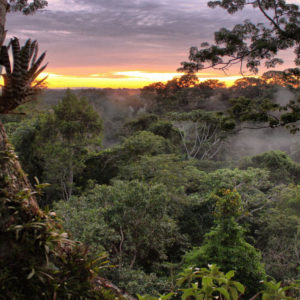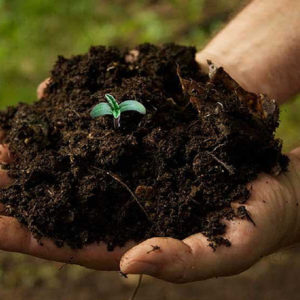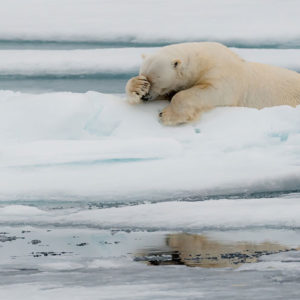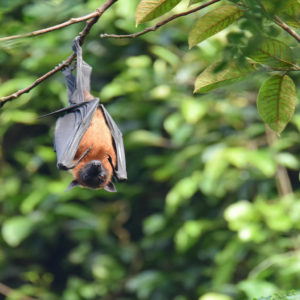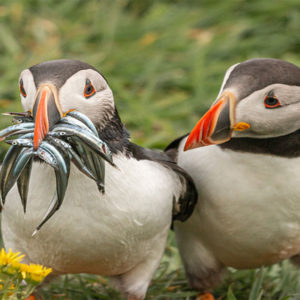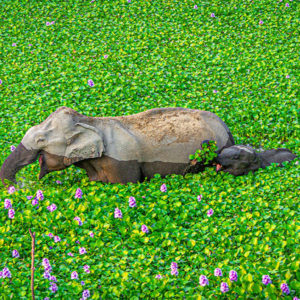Event Virtual
HRC46 | Human Rights Depend on a Healthy Biosphere
This parallel event to the 46th Session of the Human Rights Council (HRC46), presented and discussed the report "Human rights depend on a healthy biosphere" of the Special Rapporteur on Human Rights and Environment, presented to the UN General Assembly (UNGA) in October 2020. The event was co-organized by the UN Special Rapporteur on Human Rights and the Environment, Earthjustice and the Geneva Environment Network, and co-sponsored by members of the HRC core group on human rights and environment.
About this Session
On October 2020, the UN Special Rapporteur on human rights and environment, David Boyd, presented to the UNGA his report (A/75/161) discussing the need for urgent action to conserve, protect and restore ecosystems and the biosphere as all lives rely on them and is, thus, also what human rights depend on. The report was completed by an annex on good practices (Annex to A/75/161).
HRC46 will have the opportunity to consider the report and its recommendations as it will prepare the adoption of the resolution on human rights and the environment.
In this event, we discussed the elements of the report, the obligations it clarifies, and the recommendations it formulates, in view of the contribution it offers to the coming 2021 IUCN World Conservation Congress, in Marseille, and the 15th meeting of the Conference of the Parties to the Convention on Biological Diversity (CBD COP15), in Kumming, as well as to the urgent green recovery from the current pandemic.
The report was presented by the Special Rapporteur, followed by contributions from institutions dealing with this issue and a Q&A session.
Keynote Presentation
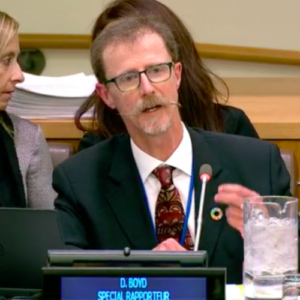
David BOYD
UN Special Rapporteur on human rights and environment
Speakers

Susan GARDNER
Director, Ecosystems Division, UNEP

Trevor SANDWITH
Director, Global Protected Areas Programme, IUCN

Luthando DZIBA
Head of the Conservation Services, South African National Parks and Co-Chair of the Multidisciplinary Expert Panel (MEP), IPBES

Elaine GEYER-ALLELY
Deputy Leader, Governance Practice, WWF-International

Winnie SENGWER
Defenders Coalition Kenya, Advocacy Officer
Summary
Welcome and Introduction
Introductory Remarks from HRC Core Group on Human Rights and the Environment
H.E. Amb. Asim Ahmed | Permanent Representative of the Republic of the Maldives to the United Nations Office at Geneva
Maldives is a country heavily depending on environmental resources, and thus appreciates the report presented by the Special Rapporteur to the UNGA, highlighting the need for urgent action to protect, preserve and restore ecosystems and the biosphere. Protecting the environment is crucial to health and wealth of the Maldives. The country is taking important steps in that redirection, such as the conservation of UNESCO biosphere reserves, and the ban of turtle and shark fishing, as well as coral mining.
We need to act now and change the ways we manage our environment to ensure we leave a healthy and sustainable environment for future generations. The resolution on the environment at the current session of the Human Rights Council (HRC46) will highlight the importance of the biosphere and the need to protect the environment. Hopefully, the resolution will be accepted by consensus. The Maldives thanks the organizers for hosting this important and timely event.
Maxime Weber | Permanent Mission of Switzerland to the United Nations Office at Geneva
Currently, the world is going through very challenging times from an environmental and climate change perspective. In these disruptive times, we need to take advantage of new opportunities to solve these pressing problems. The current pandemic clearly shows that we depend on a healthy environment, and that the enjoyment of human rights and environmental protection are mutually reinforcing. The pandemic has taught us that we need to listen more closely to science and act accordingly.
The 1990s marked a turning point in the history of multilateralism related to world trade and multilateral environmental engagement, and this includes the recognition of their interrelationship. Thirty years later, we should be ready to engage in a profound discourse on the interlinkages of the enjoyment of human rights and the prerequisite of a healthy biosphere. Both policies can and should be mutually reinforcing. Switzerland, as a member of the core group on human rights and the environment, is keen to work on progress in this regard.
Introduction to the Report | Yves Lador, Earthjustice
Today, we welcome David Boyd, leading scholar in environmental law and UN Special Rapporteur on human rights and the environment for the past three years. Last October, he presented the report “Human Rights Depend on a Healthy Biosphere” to the UNGA in New York. While this report is not the one presently discussed at the Human Rights Council*, it is highly relevant as a resolution is currently being negotiated to renew the mandate of the SR Environment and present substantial elements concerning the links between human rights and biodiversity. This discussion is also timely as we prepare for the IUCN Congress and the CBD COP later this year.
Among the three planetary crises that humanity is facing, biodiversity loss is the one for which the linkages with human rights have been the least discussed and elaborated. While a report by former SR Environment John Knox focusing on the procedural approaches to the issue was presented in 2017, the report that we discuss today focuses on the substantial dimensions of the linkages between human rights and biodiversity. It is a great pleasure to bring the discussion on this matter from New York to Geneva.
*The report currently discussed at the HRC46 is on the “Global Water Crisis”. See more information in our update on Environment @ HRC46.
Keynote Presentation
David BOYD | UN Special Rapporteur on Human Rights and the Environment
The Earth is the only planet in the universe known to support life and is home to an incredible diversity of life. Humans share DNA with all species, indicating that nature is a community to which we belong, rather than a commodity for us to exploit. All human rights ultimately depend on a healthy biosphere. Without functioning ecosystems, which depend on healthy biodiversity, there would be no clean air to breathe, no safe water to drink, and no nutritious food to eat.
A teaspoon of healthy soils contains millions of microorganisms that feed plants and protect them from pests and pathogens. Healthy ecosystems provide a renewable supply of food, fiber, food, fish, and other goods. They also regulate the Earth’s climate, filter air and water, recycle nutrients, and mitigate the impacts of natural disasters.
Yet, our activities are destroying biological diversity at a rate that is unprecedented in human history. Wildlife populations have fallen by approximately 68% since 1970. The rate of extinction is around 100 times higher than over the past 10 million years and is accelerating. One million species are at risk of extinction according to the IPBES.
The causes of this are clear. Since 1970, human population has doubled; the global economy has quadrupled; and global trade has multiplied by a factor of ten, which has sent the demand for materials and energy skyrocketing. Through all of these activities, we are literally eroding the very foundation of our health, our livelihoods and our economies, with devastating consequences for human rights.
The Covid-19 pandemic provides a striking example of this. Covid-19 is the latest emerging infectious disease to spill over from other species into humans. More than 70% of emerging infectious diseases in recent decades have had zoonotic origin, including HIV-AIDS, Ebola, Nipah virus, Marburg virus, and various straits of avian influenza. The growing risk of these diseases is causing by human activities that damage ecosystems, including deforestation, land clearing and conversion for agriculture, illegal wildlife trade and intensified livestock production.
States have created hundreds of treaties and declarations, promising to protect nature, including the 1992 Convention of Biological Diversity. Yet, there is a huge implementation and enforcement gap. States failed to meet any of the 2010 Nature Targets, and failed to meet any of the 2020 Aichi Biodiversity Targets. States are not responding with appropriate urgency to the dire warnings issued by the world’s leading scientists. On the contrary, States encourage damage to ecosystems and biodiversity by providing more than 500 billion $USD annually in subsidies that harm nature, which is more than five times what States spend to protect biodiversity.
The degradation of ecosystems and the decline of biodiversity have profound consequences for the enjoyment of human rights. Among the human rights threatened and violated include the rights to live, health, food, a healthy environment, water, an adequate standard of living, culture, indigenous people’s rights and the rights of the child.
Communities protected by healthy mangroves systems are less likely to suffer deaths caused by cyclones, which protects the right to live. Healthy ecosystems provide a buffer against emerging infectious diseases, safeguarding the right to live and the right to health. Insects, bats and birds pollinate more than 75% of crops, essential to fulfilling the right to food. The destruction of ecosystems and biodiversity violates the right to healthy and sustainable environment.
Because of their strong dependence on nature, indigenous people and local communities are disproportionately harmed by ecosystem degradation and biodiversity loss. However, indigenous people, local communities and peasants can make enormous contributions to conserving and sustainably using biodiversity when empowered to do so through recognition of their rights.
The report on “Human Rights Depend on a Health Biosphere” argues that States should apply a rights-based approach to all aspects of conserving, protecting, restoring, using, and benefiting from healthy ecosystems and biodiversity. Examples of the procedural obligations of States include providing the public with accessible information about the global nature crisis, ensuring inclusive, equitable and gender-based approaches to public participation, protecting the environmental human rights defenders who are defending ecosystems from violence, harassment and intimidation, and enabling affordable and timely access to justice and effective remedies for all to ensure accountability.
When we turn to the substantive obligations, States must for example monitor and report on the state of biodiversity, implement national biodiversity plans, create protected areas and establish other effective conservation measures, enact and implement legislation to protect endangered species, and restore degraded ecosystems.
With respect to indigenous people, States must recognize the land titles, tenures and rights, acknowledging the existence of different customs and governing systems, including collective ownership. Similar measures should be taken for local communities and peasants. Business and large conservation organizations must do more to respect human rights and do no harm in their work.
The annex to the report contains hundreds of inspiring examples of good practices in conservation, protection and sustainable use of biodiversity, including the High Ambition Coalition for Nature and People, the European Green Deal, and the African Great Green Wall. In conclusion, the report provides detailed recommendations for States in four key and interrelated areas:
- A carbon-neutral nature-positive recovery from the pandemic
- Urgent action to target the key drivers of zoonotic diseases
- Accelerated action to protect and conserve nature
- Respect of the rights of indigenous people, local communities and peasants as we make progress in conservation targets
It is not too late to respond to the global nature crisis, but time is running out. The ongoing failure to conserve, protect and sustainably use the Earth’s ecosystems exacerbates inequality, and has catastrophic consequences for the enjoyment of human rights. Today, the world’s leading scientists are all calling for rapid, systemic and transformative changes to address the climate emergency, the nature crisis, and to avoid future pandemics. With Covid-19, humanity is paying a terrible price for ignoring the warning of scientists. We must not make that mistake again.
Employing a rights-based approach can serve as a catalyst for accelerated action to protect nature. History demonstrates, through the progress achieved by abolitionists, suffragettes, civil rights activists, and indigenous people, the powerful role of human rights in sparking transformative societal changes. The time is now for the United Nations to recognize, through resolution at the Human Rights Council and the General Assembly, the right of everyone, everywhere to live in a safe, clean, healthy and sustainable environment.
Panel Discussion
Susan GARDNER | Director, Ecosystems Division, UNEP
The report makes a very strong case for nature as the foundation to human well-being. Healthy people can not live on a unhealthy planet. The impact of decades of unsustainable consumption and production, climate change, and loss of biodiversity is increasingly visible. We know now better than ever that seeking to conserve nature is in fact seeking to conserve humanity.
On 22-23 February 2021, the members of the fifth UN Environment Assembly recognized that we are facing three planetary crises: biodiversity loss, climate change, and pollution. In 2020, many people around the world experienced true environmental disasters, from flash floods in Afghanistan, to hurricanes in Central America and wildfires in the United States and Australia. It is hard to put into words the impacts of climate change on crop production and livelihoods, the loss of a forest and the vital resources it provides to many people, or the desperation of climate refugees.
We need to urgently address these crises and make a healthy environment universally recognized as part of our basic human rights. UNEP support a rights-based approach to achieve the SDGs. Human rights cannot be ensured without a safe, clean and healthy environment, and sustainable environment governance cannot exist without respect for human rights. This relationship is increasingly recognized and enshrined in over 100 national constitutions.
The pandemic has highlighted that we need to protect the environment and address inequality in order to achieve the 2030 vision of living in harmony with nature. Many indigenous people and local communities are under threat just for protecting their lands, and this is something we cannot afford to backslide on. We need to strengthen human right aspects of existing global frameworks and link ambition with concrete action that benefits the most marginalized people. While indigenous people comprise less than 5% of global population, they protect 80% of the world’s biodiversity. Areas most threated by environmental degradation are also the home of indigenous people. Moreover, the important role of women in safeguarding livelihoods needs to be considered, as women and girls are hit harder by environmental disaster and climate change.
While countries have taken pledges, such as the High Ambition Coalition for Nature and People or Leaders’ Pledge for Nature, we need to ensure that a strong post-2020 biodiversity framework is adopted. It is essential that indigenous people and local communities’ rights be mainstreamed in the processes and actions that stem from the three key international agreements on climate, biodiversity and desertification.
Nature-based solutions can help achieve biodiversity and climate goals, while protecting livelihoods and rights. They can provide one third of the emissions reduction that is needed to keep global warming under 1.5°C. 2021 kicks off the UN Decade for Ecosystem Restoration, creating a huge opportunity to raise the ambition and action. Led by UNEP and FAO, the decade will leverage international, regional and national efforts for restoration and contribute to climate mitigation, food security and biodiversity conservation. It is essential that restoration is fairness and that it respects and enhances the rights of the poorest and most vulnerable. In that regard, appropriate collaboration with indigenous people is a key component.
For decades, conservation efforts have often led to displacement and denied access to the traditional territories of indigenous people and local communities. The UN is taking action to build a inclusive, resilience and sustainable future for indigenous people. In 2018, UNEP adopted an internal policy for greater protection of environmental human rights defenders. In March 2019, the HRC calls for other UN bodies to adopt similar approaches.
Finally, we need to formally recognize the right to a safe, healthy and sustainable environment at the international level. 155 nations already legally recognize that a healthy environment is a basic human right. Formal recognition of the right to a healthy environment by States would help to elevate environment rights alongside long-recognized other human rights and give us the legal tools to stop our current planet-destroying trajectory and set ourselves on the course to live in harmony with nature.
Trevor SANDWITH | Director, Global Protected Areas Programme, IUCN
The consideration of fairness and equity in protected and conserved areas and their ability to conserve biodiversity of significant value are deeply connected. The report clearly highlights that when protected areas do not respect substantive and procedural rights, they will have negative impacts on people, society and sustainability. Conversely, when human rights at those at the local level are not respected, biodiversity outcomes will be comprised. If one does not intervene, this can become a vicious cycle. The report also highlights the independence of the right of people to an environment that promotes their health and well-being and respect for the rights to identity, justice and equity.
From the point of view of IUCN, the recognition of this mutual dependence of people and nature is paramount. The IUCN World Conservation Congress has taken numerous resolutions on this issue. IUCN is striving to uphold standards: conservation is not just about how much, but how well and through what process. Successful conservation must achieve both biodiversity and social outcomes. One interesting standard in that regard is the IUCN Green list of protected and conserved areas, which provides examples of successful cases and how they can be amplified.
When measuring the performance of protected and conserved areas across a wide range of variables, it is quite apparent those on governance, equity, rights and social justice area the best predictor of successful outcomes. Without social justice, procedural rights and fairness, there will be not effective conservation. This is proven by the data gathered in many places around the world.
Contemporary conservation practices are still dominated by governance by governments. However, we need to recognize the role of other actors, including indigenous people, and foster shared governance. It is also important to realize that a part of governance is hidden. Large parts of the planet are conserved by people, but are not formally recognized as such nor reported to international agreements. For instance, while 15% of the Amazon is formally designated as protect area in various countries, this whole precious ecosystem is conserved under the custodianship of indigenous people and local communities. Therefore, it is critical to properly recognize these age-old traditional ways of conserving the environment, support them and defend them. If the rights of the custodians of these places are not appropriate recognized and supported, we are facing a calamity in plain sight.
There is a growing agreement that we need much more ambitious targets to stem the loss of biodiversity and ecosystems on which humanity depends. It is easy to spread the message that we need more protected and conserved areas. However, we have to ask ourselves whether they are not already there in the hands of people who are their custodians. It would be a greater service to the many custodians who are out there to somehow co-opt their contribution into systems that are currently not involving them in appropriate ways.
To conclude, concerted effort to recognize the right of the custodians are essential. We need to understand where and how biodiversity is conserved by these custodians, and make sure we have the mechanisms, including the right kind of investments, to support, defend and integrate them into global efforts to address the biodiversity crisis. Agreements on the post-2020 global biodiversity framework later this year must ensure that the highest standards for both governance and management are in place to maintain the existence and sustainability of life on earth and the lives of the custodians.
Luthando DZIBA | Head of the Conservation Services, South African National Parks and Co-Chair of the Multidisciplinary Expert Panel (MEP), IPBES
The report by the SR Environment is very timely, especially in light of the linkages between the pandemic and the loss of biodiversity. The report makes a very strong point that all human rights ultimately depend on healthy biosphere. Human damages to the biosphere is having major impacts on lives and livelihoods. The IBPES assessments, which is substantially cited in the report, provides extensive evidence to support this argument.
The Global Assessment Report on Biodiversity and Ecosystem Services, published in 2019, showed that life on earth is deteriorating very fast, as all indicators of the global state of nature are decreasing. This loss is a direct result from human activity and constitutes a direct threat to human well-being all over the world. Direct drivers of these trends include changes in land use and sea use, direct exploitation of biodiversity, climate change, pollution, and alien invasive species. Interventions to safeguard biodiversity should address these drivers and explore how we can mitigate the impacts of these activities on biodiversity.
Indirect drivers of biodiversity loss include issues of governance and accountability, but also the growing human population and increasing per capita consumption. These aspects are within the sphere of influence of basically everybody on the planet. It is important to recognize that we can change some of behaviors in ways that can contribute meaningfully to halting the loss of biodiversity, and hence improving human well-being.
The IBPES findings paint a dire picture of the state of nature. 75% of the terrestrial environment and 66% of the marine environment has been severely altered by human activities. Out of the 8 million estimated species of animals and plants, up to 1 million are threatened with extinction. More than 85% of wetlands have been lost since the 1700s, greatly affecting the essential biodiversity and ecosystem services that these environments safeguard, including the provision of clean water. The significant growth of food production and global per capita consumption of materials from nature reveals the extend to which we are exploiting nature. Our impact on nature is significant and continues to negatively impact nature. The loss of biodiversity is not something in the distant future. It is within our reach and happening now, such as the global pandemic revealed.
Regarding the essential role of indigenous people, IPBES has been working on how to integrate indigenous and local people’s knowledge into our understanding of the biosphere, and how to ensure that this knowledge is meaningfully recognized. Without this recognition, we will definitely negatively impact their rights, quality of life, well-being and cultural identity. It has become clear that everything we do needs to recognize the role indigenous people play in the management of natural resources.
IPBES has also published a report on biodiversity and pandemics, which showcases significant parallels with the report from the SR Environment. It concluded that 70% of emerging diseases are caused by microbes of animal origin which spill over due to contact with wildlife, livestock and people. Mammals, such as bats, rodents, primates, birds and livestock, are the primal reservoirs of pathogens that cause pandemics. Human interaction with these mammals significantly increases the risk of pandemic. This risk is driven by the exponentially increasing impacts of humans on the environment. We cannot blame wildlife for the diversity of microorganisms they have, rather we should take responsibility for the way we relate to and manage the natural environment. Therefore, unsustainable exploitation of the environment is not a path we can continue on.
In conclusion, current negative trends in biodiversity and ecosystems continue to undermine progress toward the achievement of the SDGs. Our ability to achieve the king of change we need will only be possible through transformative changes across economic, social, political and technological spheres. Efforts have to be holistic and cut across multiple sectors.
Science is clear and we should not ignore the evidence. We need to champion and act on science. The SR Environment has showed excellent leadership in that direction by drawing on the most recent evidence to present his report. It is very encouraging for platforms like IPBES to contribute meaningfully to decision-making and we look forward to the uptake of this science at the IUCN World Conservation Congress and the Conference of the Parties of the Convention on Biological Diversity later this year.$
Elaine GEYER-ALLELY | Deputy Leader, Governance Practice, WWF-International
The report by the SR Environment provides three ways that help us move ahead in how we understand, how we collaborate and how we act for people and for nature to the recognition of a human right to a healthy environment.
First, the report provides substantial evidence on the vital links between human rights and the environment. As such, it is a solid foundation for recognizing how much we depend on nature, as the pandemic has clearly revealed. In its work, WWF has come across many more examples of this deep interconnection, for instance witnessing coastal communities in the Arctic losing their home and land due to the effects of climate change. This story illustrates the deep connections between substantive human rights and the environment. It is essential that those recognized at the major conferences this year and in the decisions of the Human Rights Council.
Secondly, the report helps us build a common understanding and vision so that we can take more effective action for people and the planet. The work done by SR Environment is essential to build a bigger and more vocal coalition of people who are looking for holistic approaches to environmental, social and economic crises. The recovery from the pandemic is the opportunity to build sustainable and equitable societies. This will require to shift our understanding of our place within the biosphere and to resolve social inequalities as well.
The WWF mission is aligned with the core message of the human right to a healthy environment. We see a role to play in sharing this work with our communities and partners and in our advocacy. There needs to be more people sharing a common understanding and vision across human rights and environmental communities, between government departments, and in the private and financial sector. This would allow to design more effective action to counter nature loss, environmental degradation and climate change.
Third and finally, the report makes clear recommendations to conservation organizations to more consistently implement our commitment to human rights. Human rights abuses are never acceptable, including in the name of conservation. In 2019, WWF commissioned an independent review into who it responded to reported human rights abuses in the places it works. While the panel found that no WWF staff was involved, it also showed that more could have been done in supporting communities. The WWF is now taking action to strengthen its commitment.
WWF is also bringing the next of human rights, indigenous people and nature conservation in the forefront of its work in many places and in its advocacy. WWF is part of the many organization that support the nature-positive goal to protect and conserve 30% of the planet by 2030. securing the rights of indigenous people and local communities who are the custodian of much of the world’s remaining biodiversity. WWF will soon publish a report on how conservation can benefit from a rights-based approach, which was developed in collaboration between global conservation and human rights-based NGOs, global alliances, UN entities, and indigenous people and local communities experts. This type of collaboration is essential to build vocal coalitions and foster effective action for the future.
Winnie SENGWER | Defenders Coalition Kenya, Advocacy Officer
The report clearly acknowledges the role of these communities as conservationists and custodians of traditional knowledge on conservation. Every panelist has mentioned the important role of indigenous people for protecting the planet. As an indigenous woman from the Sengwer community, I appreciate this recognition and would like to thank the Special Rapporteur and the other panelists. The report pointed out that the rights of indigenous people to the conservation and protection of the planet have been recognized in recent UN resolutions. It is our role to protect the environment.
Forests, biodiversity and ecosystems are fundamental to human rights. Indigenous people have a spiritual connection their land and the forest biodiversity. You cannot separate me and the forest. Clans are named after animals, and members of each clan will care and protect this specie. Indigenous people are playing a huge role in forest conservation through activities that protect biodiversity, such as bee keeping.
The report highlights that most medicine is derived from nature. When indigenous people are respected and allowed to live peaceful in their ancestral homes, we secure the availability of these drugs. Indigenous people also protect trees, as each family has a symbol tree and must protect it, similarly to its totem animal. Their traditions also contribute to landscape management and conservation, as they will not enter in some areas of the forests considered sacred. Forest is both the home of 80% of the biodiversity and of indigenous people. By respecting the rights of those communities who are at the forefront of conservation, we ensure this vital biodiversity is conserved.
However, many indigenous people face eviction from their land, losing their ancestral home and sense of place. Eviction deeply affects people, who lose their home, their identity and even for some their lives. Eviction also contributes to the degradation of forests, as home are brunt and fire easily spreads. As we are deeply connected with the forest, we believe that if we are left to live peacefully in our ancestral home, we will protect the forest and preserve our way of life, our language, our traditions and our knowledge.
As previous speakers have mentioned, indigenous people need to be involved in conservation. One way to do this is to ensure that indigenous voices are present in every decision-making forum on conservation. This is essential to recognize and integrate indigenous people’s knowledge which is extremely valuable. Traditional knowledge needs to be preserved and passed on for generations. The socio-economic activities of indigenous people should also be promoted, for example through funding for a bee-keeping community. Such support enables indigenous people to keep conserving the forest, as their plant trees and manage water.
Finally, ensuring land rights for indigenous people is paramount. As explained, eviction leads to environmental degradation, and thus it is beneficial for both nature and people to secure the rights of the primary owners of the land: indigenous people. For instance, eviction of a community can lead to illegal logging, thus weakening the soil, creating landslides and taking away the lives of many people. Indigenous people protect the trees, the soil, the water catchment areas and more. Letting them voice their way of practicing conservation is crucial. Maybe people have yet to understand that respecting the rights of indigenous people means respecting their land rights. Let’s ensure that indigenous people are included in conservation and advocacy, so that no one is left behind.
Q&A
Many issues remain unresolved due to red tape and politics. Shouldn’t there be a prime directive and policy to protect all life on Earth?
David Boyd: Policy failure is linked to the lack of a human right-based approach and accountability mechanisms. Currently protecting biodiversity is seen as an option for governments. However, when we introduce human rights in the picture, it becomes an obligation. Therefore, we need to prioritize putting the the rights of indigenous people in law, and pursuing actions that bring multiple benefits to human rights. Restoring ecosystems, preventing deforestation are some examples of such actions which have positive outcomes for both people and the environment. We need to create virtuous cycle where our action can be speeded up.
Susan Gardner: There are two ways to ensure that we move forward. The first is to focus on the drivers and ensure that the action we developed are specific. The second is to be prepared to accelerate action immediately after agreements are made.
Trevor Sandwith: Increasing accountability is crucial to move forward. From a top-down approach, the post-2020 biodiversity framework should create benchmark targets that can act as incentive for progress. Meanwhile, a bottom-up approach focusing on the virtuous cycle can also bear fruits, as we look at stories of successful conservation by indigenous people and work to amplify that message. It is important to show that these practices really work and benefit everyone.
What were the limitations that brought you to adopt a collaborative approach?
Elaine Geyer-Allely: The State of IPLC’s Land Report, which should be published in April, stems for work that began in 2017 in governance practice to put stronger focus on rights-based approaches and specifically helping indigenous people and local communities. It grew out of conversations with colleagues from different sectors on the need to have a unified voice. Advocating together and showing our common agreement among different sectors can make the power of advocacy much bigger. Collaboration can help us shape up our voices and make it more effective.
What are the impacts of Covid and much was the health of indigenous people affected by Covid-19?
Luthando Dziba: The IPBES Pandemic Report suggests that the impact of the pandemic accounts for trillions of dollars on the global economy. These impacts are not evenly distributed and disproportionately affect developing countries, but also more vulnerable groups within each country due to the existing inequalities, for instance with relation to access to water and sanitation.
Winnie Sengwer: Indigenous people suffer disproportionately from the pandemic. They often lack access to information and medical facilities. Restriction of movement imposed by governments often complicated access to essential health services. Initiatives have emerged to support women, for instance by providing training and seed funding for soap making. This provides both better sanitary conditions in communities and a new socio-economic activity for women. As a concluding work, I call on all of you to keep advocating for indigenous people’s land rights and ensure that governments respect it.
Closing
Video
In addition to the live WebEx and Facebook transmissions, the video is available on this webpage.
Documents
- Human rights depend on a healthy biosphere | Report of the Special Rapporteur on the issue of human rights obligations relating to the enjoyment of a safe, clean, healthy and sustainable environment, David R. Boyd | 15 July 2020
- Annex to A/75/161
- Invitation
- Presentations made during the event
Links
- Environment @ 46th Session of the UN Human Rights Council
- Special Rapporteur on human rights and the environment
- Why all human rights depend on a healthy environment | David R Boyd, UN Special Rapporteur on human rights & environment | 27 October 2021


